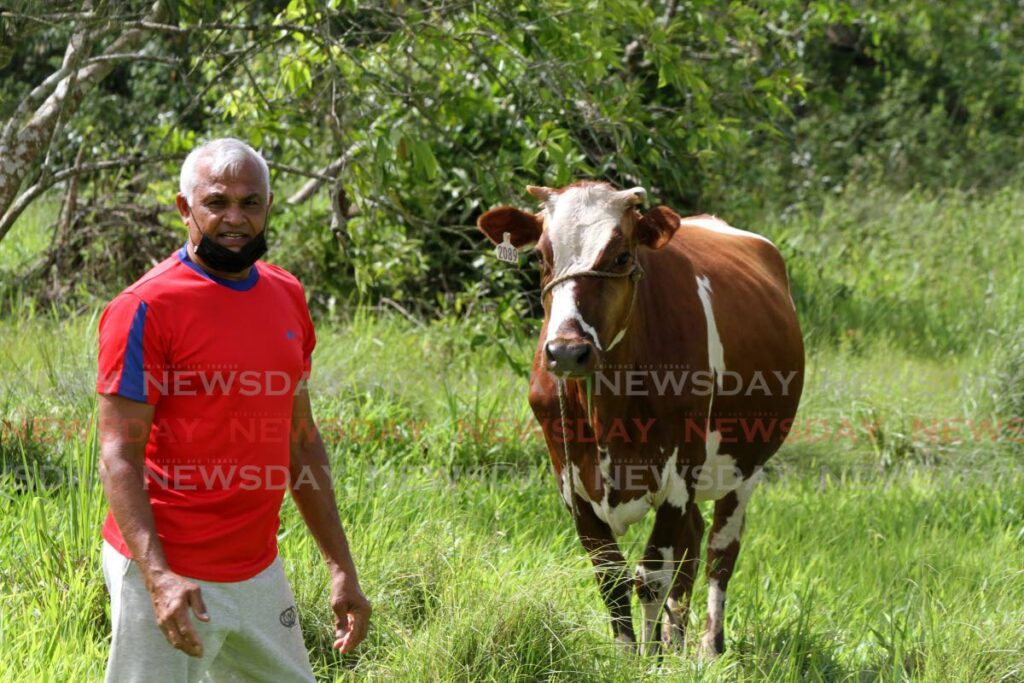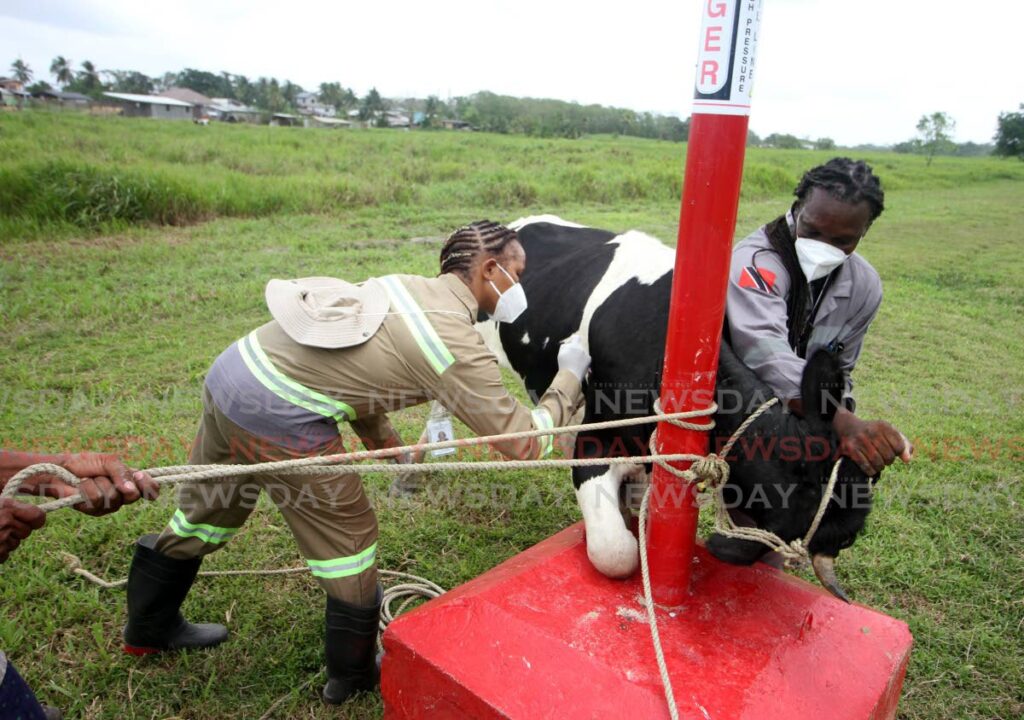Battle against bats of Barrackpore

Less than one per cent of Trinidad and Tobago’s bat population has rabies.
Of the 68 species of bats in the country only two species, both vampire bats – the bovine-loving "Desmodus rotundus" and the white-winged "Diaemus youngi" that feeds on birds – can efficiently transmit rabies because of their unique feeding habits.
Even with that small percentage, the Desmodus rotundus or common vampire bats have been causing havoc in the district of Barrackpore in southern Trinidad over the past two months, killing about 29 heads of cattle and two sheep.
Cattle and poultry farmer Seetal Persad, 61, lost a male calf and a cow to the disease, leaving him with nine cows.
He told Sunday Newsday his parents used to care for cattle and he continued their tradition. Growing up he would see drops of blood on the animals’ shoulders and knew bats bit them but nothing ever happened to them. In his 50 years of raising cattle, he never knew rabies was so dangerous.
He recalled at the beginning of March one of his calves started dripping saliva from its nose and mouth, stopped drinking milk or eating, started drifting when it tried to walk, and eventually could not stand anymore.
By the time it died, a second animal had similar conditions and he called the Ministry of Agriculture, Land and Fisheries for help. Members of the Anti-Rabies Unit visited with a veterinarian who believed the animal had rabies.

They asked permission to euthanise and test the animal which confirmed it had rabies and vaccinated his remaining cattle.
“Seeing what the first one went through was really heartbreaking. To see him lie down on the ground, he couldn’t eat even as I tried to feed him. And seeing that I was in direct contact with him and I didn’t use a glove, my wife and I had to get the rabies vaccines.”
He said his family loves animals. In addition, it was a big commitment and a lot of work to care for them in the sun or rain and to ensure their safety during floods so it was difficult to lose them.
“I was thankful for the information the doctor gave us to go and get the vaccine because I never knew the vaccines were available for humans too. Because they said the same way there’s no cure for the cow if they get bitten before vaccination, there’s no cure for a human once you start showing symptoms.”
Cattle farmer Ramesh Rampersad had 13 heads of cattle before three died from rabies.

He said one day the cattle were running around and eating just fine, the next day a cow started drifting and on the third day it died. Three days later, his prized breeding bull also died.
He explained officers from the ministry visited for a scheduled vaccination of his cattle. When they saw the animal, they did not vaccinate it but called a veterinarian who said the animal had rabies. They immediately made an appointment for him to go to the health centre and get vaccinated as well.
The officers called to follow up on the health of the animal and he informed them it died. Eventually, he lost three animals worth about $25,000.
Rampersad said he used to mind sheep, goats, ducks, and cattle but has been minding cattle exclusively for the past 11 years. He sold the milk as well as fruits and vegetables from his garden to earn a living.
“I have always been in farming and this is the first time I come across anything like this. I never vaccinate my cattle because I never come across this rabies. It’s discouraging. This is my livelihood.”
He believed more than 27 animals in the area died from rabies and initially, most farmers did not know why.
He said he would like the ministry to check up on and control the bat population more often so he and the other farmers in the area could feel better about their animals’ safety.
What to do if bitten by a vampire bat
Dr Janine Seetahal veterinary officer of the Animal Production and Health unit at the Ministry of Agriculture and acting head of the Anti-Rabies Unit emphasised that not all bats were vampire bats, and not all vampire bats had rabies.

“You cannot get rabies just from seeing or being in the same area as a bat. So bats flying around outside your house pose no threat to you, in fact, they may be saving you from other diseases such as dengue, Zika or chikungunya on account of the large amounts of mosquitoes they consume on a nightly basis.”
She explained there were two forms of rabies, furious and paralytic, which differed in the primary way the disease manifested. Furious or classic rabies circulated in the dog population and is manifested as aggression or hyperactivity. It is not the form of rabies usually seen in TT.
Paralytic rabies is found in vampire bats. Infected cattle pass very little urine or faeces, salivate excessively and will show signs of weakness or incoordination progressing to paralysis before dying by day five of the disease. Sheep and goats may show aggression, circling or head pressing before becoming paralysed and dying.
In the 1920s paralytic rabies was a mystery. People did not know what was happening in the animal population because no one knew about bat-transmitted rabies.
It crossed over into the human population in 1929 and by the 1930s, TT had one of the largest paralytic rabies outbreaks in the world.
“In the 1930s, close to 100 human and thousands of livestock rabies cases were seen in a large multispecies rabies outbreak in Trinidad. When they went back to the records they realised people had a history of being bitten by bats.
“So during this outbreak, Dr Joseph Pawan isolated the virus from the brain of an abnormally behaving bat which was the first time that rabies transmitted by bats was recognised anywhere.”
In the last 50 years, there were five major rabies outbreaks in the livestock population in 1974, 1997–1998, 2000, 2010 and 2012–2013, with the highest annual case number occurring in 1997 with 56 cases.
The last case of paralytic rabies in a human was in 1937.
Seetahal explained that a rabid bat usually had difficulty moving but some bats had and could transmit the virus although they were not symptomatic. Also, bats could transmit the virus before they show symptoms.
“Bats are shy and gentle but they are wild animals so if they see you, they get scared and fly away. If that instinct is not kicking in and you are able to approach a bat, you need to be cautious.

“They are cute so I understand why someone may want to pet a bat but if a bat is lying on the ground or has settled low on a wall, something may be wrong with it. It could just be hurt or it could have rabies. Do not touch the bat or try to handle it with bare hands.”
Vampire bats have small bodies that could fit into the palm. They have small noses, flat faces, long thumbs, can jump, walk, creep, and are very agile. Instead of large canines, they have distinct front incisors which they use to scoop out a small piece of flesh from which they lap blood. A groove on the lip channels the blood into the mouth.
“If you think your pet has been bitten by a bat or has been found with a bat in its mouth immediately contact your veterinarian, rabies vaccination may be necessary.
“If you are bitten by a bat, immediately wash and flush the wound thoroughly with soap and water for at least 15 minutes. Apply a disinfectant such as isopropyl alcohol or povidone-iodine to the wound and surrounding tissue and then immediately seek medical attention. You would need to be vaccinated against rabies to prevent the disease in the event that the bat was rabid. It is important to complete the treatment in order to prevent rabies.”
Vampire bats live only in the Americas with TT and Margarita being the only islands in the Caribbean that have them. And they usually live in the forests in hollow trees and caves.
Seetahal said with deforestation and people cutting down their habitat to build homes, the bats adapted to live in dark man-made structures including tunnels, drains, and culverts.

“They have been here before we were here. Previously they would have lived on indigenous wildlife like quenk and agouti. Their population expanded when the colonisers came and brought domestic livestock and they had this easy source of food. It was like a feast for them and in response, their numbers multiplied.
“If the livestock industry goes down and the number of bats stays steady, they will have to look for something else to feed on and they will feed on other sources including horses and people. Livestock is a buffer for us really.”
One field officer said they only used to vaccinate cattle against rabies but, over the past decade or so, as the number of cattle dwindled, they have been vaccinating sheep and goats as they too are now being bitten.
The recent spike in rabies cases occurred in February in Barrackpore.
The Anti-Rabies Unit officers went into the area where the first case was identified and plotted a radius using the vampire bats’ usual flight patterns. They have been vaccinating livestock that has not been vaccinated or is due for a booster.
“The ministry responds to farmer requests for vaccination because it’s the easiest way to do it with our limited staff. So there are a lot of animals that have not been vaccinated.”
In response to the latest cases in Barrackpore up to March 31, 1,881 animals were vaccinated including 786 cattle, 659 sheep, 403 goats, and 33 buffalo.
Seetahal said vampire bats are on the vermin list so they are under population control. Officers would catch the bats, put poison on their bodies and release them. The bats would go to their roosts where they would groom each other and “treat” 20 to 40 other vampire bats.
“In my view, every creature has its purpose. Nobody should go out there to eliminate anything God made. The high numbers of vampire bats that have established themselves are because humans came and brought additional prey, throwing off the ecological balance. So it’s a matter of controlling the population.
“In fact, scientists are now finding out the saliva of the Desmodus rotundus may hold the key to more effective medical treatments for stroke victims and cardiac patients.
“It has potent anticoagulants and vasodilatory components in its venom which are found to be suitable drug candidates for the treatment of strokes, hypertension and heart failure. So who knows one day a vampire bat may save your life.”


Comments
"Battle against bats of Barrackpore"